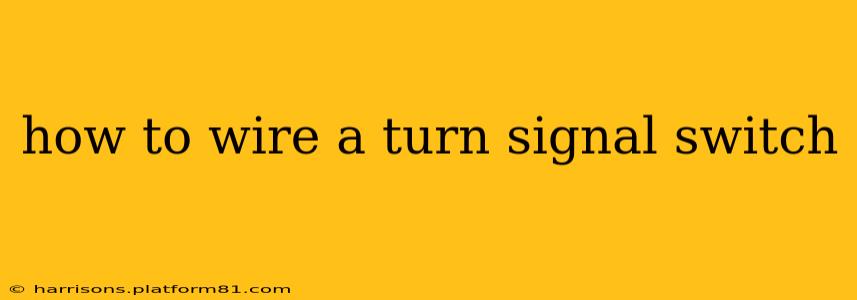Wiring a turn signal switch might seem daunting, but with a clear understanding of the process and a methodical approach, it's a manageable task for even moderately skilled DIYers. This guide breaks down the process step-by-step, addressing common questions and providing troubleshooting tips. Remember safety first! Always disconnect your battery's negative terminal before starting any electrical work on your vehicle.
Understanding Your Turn Signal Switch
Before jumping into the wiring, it's crucial to understand the components involved. Your turn signal switch isn't just a simple on/off switch; it's a more complex mechanism that controls various functions, including:
- Left Turn Signal: Activates the left-side turn signals.
- Right Turn Signal: Activates the right-side turn signals.
- Hazard Lights: Activates both left and right turn signals simultaneously.
- Horn: Often integrated into the switch assembly.
The specific wiring configuration will vary depending on your vehicle's make, model, and year. Always consult your vehicle's repair manual for the most accurate wiring diagram.
Identifying Your Wires
The next crucial step is correctly identifying each wire. This requires careful examination of your vehicle's wiring harness and your turn signal switch. Look for color-coded wires; the color coding is usually consistent within a vehicle's system. Common wire colors associated with turn signals include:
- Green/Yellow: Often used for the left turn signal.
- Green/Blue: Often used for the right turn signal.
- Brown: Often used for ground.
- Red: Often used for power.
- Black: Often used for ground or other functions depending on the vehicle.
Important Note: Wire colors can vary. Refer to your vehicle's wiring diagram for confirmation.
Common Turn Signal Switch Wiring Configurations
There isn't one universal wiring configuration. However, some common patterns exist. The exact connections will depend on your vehicle and switch. Here's a general idea:
- Power Source: A wire from the ignition switch supplies power to the turn signal switch.
- Left Turn Signal Output: This wire carries the signal to activate the left-side turn signals.
- Right Turn Signal Output: This wire carries the signal to activate the right-side turn signals.
- Hazard Light Output: This wire sends a signal to activate both left and right turn signals simultaneously.
- Ground: The ground wire completes the circuit, allowing current to flow.
How to Wire a Turn Signal Switch: A Step-by-Step Guide
This is a general guide; specifics will differ depending on your vehicle. Always consult your vehicle's service manual.
-
Disconnect the Battery: Disconnect the negative terminal of your vehicle's battery. This prevents accidental shorts and protects you from electrical shocks.
-
Remove the Steering Wheel (If Necessary): Some vehicles require steering wheel removal to access the turn signal switch. Consult your repair manual for the correct procedure.
-
Remove the Turn Signal Switch: This usually involves removing screws or clips securing the switch to the steering column. Again, your repair manual will guide you.
-
Identify the Wires: Carefully identify each wire using your vehicle's wiring diagram and color codes. Label each wire clearly with masking tape and a marker to avoid confusion.
-
Connect the Wires to the New Switch: Following the wiring diagram, connect the wires to the corresponding terminals on the new turn signal switch. Ensure a secure connection.
-
Reinstall the Turn Signal Switch: Carefully reinstall the switch and reassemble any components you removed.
-
Reconnect the Battery: Reconnect the battery's negative terminal.
-
Test the Turn Signals: Turn on the ignition and test the turn signals, hazard lights, and horn (if applicable) to ensure they are functioning correctly.
Troubleshooting Common Problems
- Turn signals not working: Check all connections, fuses, and bulbs.
- Hazard lights not working: Verify the hazard light switch and its connection to the turn signal switch.
- Intermittent problems: Look for loose connections or damaged wiring.
- Fuse keeps blowing: This suggests a short circuit in the wiring. Carefully check all connections.
What tools do I need to wire a turn signal switch?
The tools required depend on your vehicle's access points. Commonly needed tools include:
- Screwdrivers (Phillips and Flathead): For removing screws and panels.
- Wrench(es): Possibly needed for disconnecting components.
- Wire Strippers/Cutters: To prepare the wires for connection.
- Crimping Tool: For attaching connectors to the wires (if required).
- Multimeter (optional): Helpful for testing electrical circuits.
- Vehicle Repair Manual: Essential for obtaining the correct wiring diagram and procedure.
What if my turn signal switch is integrated with other components?
Many modern vehicles integrate the turn signal switch with other controls like wipers, cruise control, or headlight functions. Repairing or replacing such a switch requires more advanced knowledge and caution. In such instances, it is strongly recommended that you consult a qualified professional.
By following these steps carefully and consulting your vehicle's manual, you should be able to successfully wire a turn signal switch. Remember, if you're unsure about any part of this process, it's always best to consult a qualified mechanic. Safety should always be your top priority.
